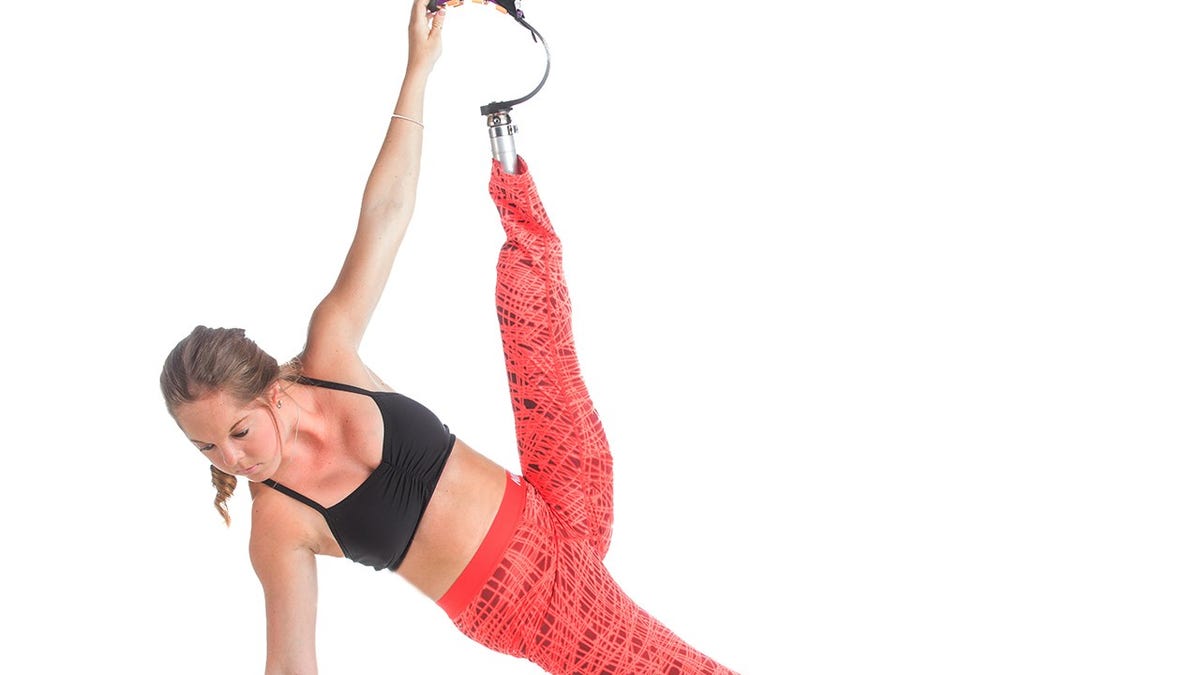
Courtesy of GavinSmithPhoto.com (Courtesy of GavinSmithPhoto.com)
This March, Kelsey Koch, 24, accomplished a major goal: She opened her own yoga studio in her hometown of Grand Blanc, Michigan. It's an exciting feat for any devoted yogi, but for Koch, it's especially personal: Owning her own studio allows her to host yoga workshops for people with amputations, like herself.
Born without a tibia, Koch had a through-the-knee amputation on her left leg when she was just 9 months old. Koch says she grew up wearing a prosthetic leg that looked realistic but wasn't practical for exercising. "It’s easy to get caught up in what people think and wanting [a prosthetic] to look as normal as it could," Koch tells SELF. "It is a beautiful leg—it has skin, it has toenails, it has everything—but it’s just not functional for activities like yoga or running."
Koch discovered yoga at age 22 after she started working with a personal trainer to treat her scoliosis, which was caused by her amputation. Her trainer suggested she try yoga. "Yoga makes you work both sides of your body," Koch says. "I’m so dominant on my right side, so I first started yoga to hopefully strengthen out my left side."
Her realistic prosthetic, which she calls her "pretty leg," made her first attempts at yoga difficult because of its heavy weight and stiff structure. So her trainer suggested she switch to a running blade prosthetic, a lighter model designed for fitness. It made a huge difference in her practice. "With the running blade, it was a lot lighter so I could do inversions a lot easier."
More From SELF
But mastering advanced inversions with her legs over her head wasn't an immediate thing. "You really have to be mindful of how much you practice and really put time and effort into it to really see the benefits," she says. Koch dedicated herself to her practice, and her passion for yoga grew—as did her strength.
She completed a 200-hour yoga teacher training in May 2016. And in December, she took her practice to the next level with a prosthetic leg that lets her attach a sneaker. With the blade, she struggled with balance, and with a sneaker she can better distribute her weight.
She started teaching yoga at her nearby athletic club, but she dreamed of having her own studio. That dream became a reality at the start of 2017, when she secured a space. Her studio, Serenity Yoga, opened its doors last month. "It's great to teach yoga on a daily basis, and I’ve always wanted to teach to amputees—now I’ll get to do both," Koch says.
The classes at Serenity Yoga are for people of all abilities, but starting in May Koch will host a weekly workshop for amputees. It's the only amputee-specific yoga class she knows of, and she's titled the workshop "No Limbitations." She's partnered with local prosthetic companies to help her find people with amputations interested in trying yoga. Her first workshop is next month—and she's ecstatic. "I’m just really excited to have the amputee workshop to see everything come full circle," she says. "[The people attending] can see me, and they'll know, ‘I can do it. Maybe not today, maybe not tomorrow, but eventually if I keep trying I can do it.' And I can help them, knowing exactly what they feel like going into it and how they’re going to need support or assistance."
An estimated 1.9 million people are living with limb loss in the United States, according to the CDC. But Koch says she doesn't see much representation of amputees in the yoga sphere. She's working to change that with her studio and her own Instagram account. On @kelseykoch, she regularly posts pics of her tackling difficult inversions and yoga poses, her prosthetic leg prominently displayed. She tags photos with #AmputeeYoga.
The main message she wants to give her followers and yoga students: "Every body is a yoga body," she says. "Just because you may be different in some ways doesn’t mean that you can’t do yoga or that you can’t do anything."

